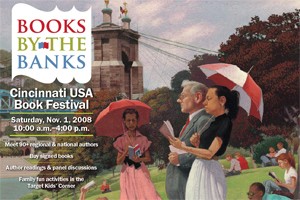
A&S Faculty, Alums Share Good Word at 'Books by the Banks'
Two Department of English & Comparative Literature faculty members and two McMicken College of Arts and Sciences alumni are among almost 100 writers to be featured in the second-annual "Books by the Banks: Cincinnati USA Book Festival."
The free festival, which runs from 10 a.m. to 4 p.m. Saturday, Nov. 1, at the Duke Energy Convention Center, promotes reading for all ages, with activities for the entire family. Writing in 15 categories, ranging from local history and travel and memoirs to adult fiction, graphic novels, spirituality and career will be available. Books by the Banks is organized by Borders Books, CET, Cincinnati Magazine, The Mercantile Library, the Public Library of Cincinnati and Hamilton County and University of Cincinnati Libraries.
Arts and Sciences alumni showcased at the event are Ellen Everman (English, 1981) and Michael Perry (Communication, 1984).
Everman, author of "Pink Dice," has written fiction and nonfiction for publications including The Sunday Challenger and The Kentucky Post. "Pink Dice" (Acclaim Press), according to press material, "paints a vivid and unforgettable picture of the border town area known as Northern Kentucky/Cincinnati."
Perry's "Xavier Tales: Great Stories from Musketeers Basketball" (Pone Press) is the first book to chronicle the success of the Xavier men's basketball. A former Enquirer sports editor who also authored "Tales from Cincinnati Bearcats Basketball," Perry is the Enquirer's managing editor for non-daily products and new initiatives.
Jim Braziel, adjunct assistant professor of English & Comparative Literature, is the author of "Birmingham, 35 Miles," published by Random House in early 2008 as part of a two-book deal.
He describes "Birmingham" as a novel about an environmental disaster in the South, about the struggle of one of its inhabitants, Mathew Harrison, "to make sense not only of the word he's grown up with (a desert wasteland much like the 1930s dust bowl), but the past world of his father and mother (with its crops and as Mat puts it, "green with a ceiling of blue and thick-shouldered clouds I've never known," a breathable life), and the world just north (unknown, but supposedly still alive, where his wife, Jennifer, is heading). He finds himself trapped in these geographies dreamed, remembered, and lived."
Being part of "Books by the Banks" is exciting for Braziel, who lauds the city's dedication to promoting local and regional writers.
"It's an honor to participate," Braziel says. "The commitment is strong Cincinnati has a long history of supporting the arts, and Books by the Banks is another example of that support."

Wilson
One of his main aspirations is to create fiction and poetry that connects to readers, Braziel says. And reaction to his book has been positive.
"Readers want to know what's going to happen in the second book ('Snakeskin Road'), which I'm currently revising," Braziel says. "So, yes, I am deep into the second book." "Snakeskin Road" will be out in August 2009.
Also participating is James Wilson, professor of English & Comparative Literature. His "Weather Reports from the Autism Front" is a darkly funny, painfully honest memoir of life with his autistic son, Sam, who's now 26. The book, published by McFarland in early 2008, "has been well received by the wider autism and disability communities," Wilson says.
"I get e-mail all the time from parents and professionals who've read my memoir and who say they now have a much better understanding of autism. That, in itself, makes me feel good about the book," he says.
Being part of Books by the Banks feels good, too.
"I'm honored to be accepted and recognized by our community, especially in a literary event of this magnitude," Wilson says. "I think it speaks volumes about our community that books and reading are recognized as being central to our lives."
Related Stories
Ancient Maya blessed their ballcourts
April 26, 2024
Using environmental DNA analysis, researchers identified a collection of plants used in ceremonial rituals in the ancient Maya city of Yaxnohcah. The plants, known for their religious associations and medicinal properties, were discovered beneath a plaza floor upon which a ballcourt was built, suggesting the building might have been blessed or consecrated during construction.
OTR mural centerpiece of 'big' celebration of UC alumni
April 26, 2024
New downtown artwork salutes 18 alumni award recipients who personify UC’s alumni success.
From literature to AI: UC grad shares career path to success
April 23, 2024
Before Katie Trauth Taylor worked with international organizations like NASA, Boeing and Hershey, and before receiving accolades for her work in the generative AI space, she was in a much different industry: English and literature.
